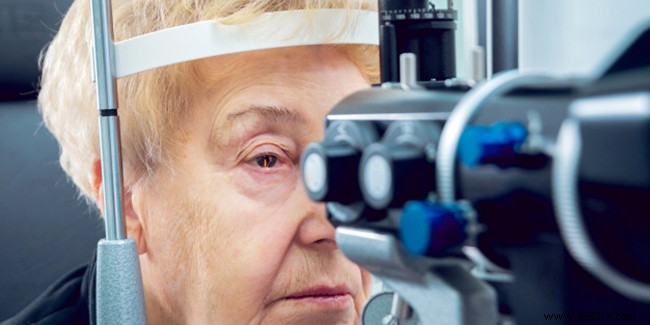
Glaucoma is an eye disease that affects the optic nerve of the eye and is most likely to occur with aging. Glaucoma causes a change in the visual field which can go as far as partial or total blindness, especially if it is not treated in time. How to recognize the symptoms of glaucoma? What are the ways to treat it? Our explanations.
According to the Federation of the Blind of France, nearly one million people, or 2% of the French population is affected in France by glaucoma. A disease more common from the age of 45.
Glaucoma is a disease that affects the eye, and more specifically the optic nerve, which results in hypertension inside the eye with the consequent compression of its nerve fibers resulting in an alteration of the visual field.
Glaucoma has the effect either of slowing down the flow of the aqueous humor of the eye, a transparent liquid which has the function of maintaining good eye pressure and which, normally, is renewed naturally, we then speak of open-angle glaucoma , or to stop this flow (angle-closure glaucoma).
The causes of glaucoma can be multiple. First, this disease is more likely to appear with aging. It can indeed occur from the age of 40-45, and its frequency then increases with age.
A family history can also explain glaucoma. On the other hand, nearsighted people, who suffer from high blood pressure, diabetes or sleep apnea are more exposed to this disease. Finally, those who take corticosteroid treatments for a long time also have a higher risk of declaring glaucoma.
Initially, and for a fairly long time, even if it is present, glaucoma is difficult to detect because it does not necessarily modify the sight of the person concerned. Indeed, the narrowing of the visual field can be very slow and occur only very late, once the disease is well established. This is why, in prevention, it is important to go to an ophthalmologist regularly, ideally every year, especially from the age of 45 when the risk of declaring glaucoma increases.
Since glaucoma is associated with high blood pressure in the eye, sufferers who feel pain in the eye or notice redness should go to their doctor as a precaution. In the same way, vision that becomes blurred should cause concern and prompt diagnosis, as should the occurrence of decreased vision, particularly on the sides, with the impression of being in a tunnel.
When sight is impaired due to glaucoma, loved ones can also detect signs of the disease:movement and activities, such as reading for example, of the affected person become more difficult; she no longer watches television, or else has to get very close to the screen to see; she becomes clumsy; she changes her attitude towards light, whether indoors or outdoors.
Other signs that suggest depression or Alzheimer's disease, such as becoming irritable, no longer going out, wearing stained clothes without noticing it, no longer finding one's objects, etc., can also be symptoms of glaucoma.
In the event of symptoms of glaucoma, the ophthalmologist carries out a series of examinations:measurement of intraocular pressure by tonometry (measurement of ocular tension); observation of the optic nerve head by ophthalmoscopy, more often called "fundus", or by optical coherence (OCT); examination of the angle of flow of intraocular fluid, that is to say the aqueous humor of the eye; and a visual field assessment.
Further examinations, such as Magnetic Resonance Imaging (MRI), may also be prescribed if glaucoma is suspected.
There is no treatment to completely cure glaucoma. On the other hand, it is possible to stabilize the disease in particular by lowering the pressure inside the eye. To do this, the ophthalmologist first prescribes one or more eye drops that act on the aqueous humor, to be poured drop by drop into the affected eye.
If these eye drops do not give good results on glaucoma, the doctor can then offer a laser treatment which does not require hospitalization. The purpose of this intervention is to facilitate the evacuation of the aqueous humor or to reduce its production. However, this treatment is not definitive. Patients with glaucoma are usually forced to use eye drops again a few years later.
As a last resort, glaucoma can be treated surgically during a short hospital stay or on an outpatient basis. It is an intervention whose goal is to create a new escape route for the aqueous humor or to reduce its production to maintain normal pressure in the eye.
To know: treatments intended to stabilize glaucoma, and in particular surgery, have the effect, for the person affected, of increasing the risk of developing cataracts, another disease that affects the eye.